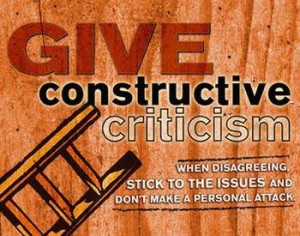Are You Able To Provide Others With Feedback?

I think it’s important that we stop looking at criticism as a bad thing and begin thinking of it more as a learning process. This is especially true when it comes to those in positions that require you to provide people with feedback. For example, a person in a management type of position needs to know how to provide people with feedback, not only for the person in the management position but the employee’s as well.
Think about it, how is a person supposed to fix their mistakes if they don’t know what they are doing wrong. I understand, criticism is a touchy subject. However, it is necessary in almost all parts of life.
Check out these tips on providing constructive criticism from wikiHow.
The art of giving critical feedback encourages a person to grow and to not feel bad. Constructive criticism improves a person’s behavior and avoids blaming and personal attacks.[1] Constructive criticism has a positive tone and focuses on clear, achievable objectives.
Giving Constructive Criticism
1. Note the difference between constructive criticism and destructive criticism.
Constructive criticism improves a person’s behavior, encouraging positive changes. Whereas destructive criticism condemns and discourages the person.
•Destructive criticism demeans, discredits and hurts people.
•In contrast, constructive criticism improves a specific behavior without personal attacks. Their self-esteem remains intact.
2. Good intentions.
Your reason for critiquing someone’s work or behavior affects how you deliver feedback. If you have an ulterior motive besides wanting to help the person improve, that’s come across as overtly negative. Reflect on whether the criticism you intend to impart will actually be productive.[2]
•Good intentions do not always get a positive response. For example, if your friend has gained a lot of weight since you last saw each other, telling her she should lose weight for her health’s sake probably won’t fall on receptive ears and, in fact, she may feel hurt. Criticizing is one of those domains where intentions are less important than what you actually say and do.
•Instead of acting on impulse, be thoughtful and ask yourself how it would sound if you told this person what you’re thinking. Are the words you choose appropriate? What about the underlying social politics? What about yourself? For example, if you want to criticize your friend about her weight and you’re naturally thin, think about how she may feel to receive this feedback from you, someone who has never struggled to lose weight nor experienced weight-based discrimination.

3. Is the criticism warranted?
If someone requests feedback and is willing to change, then constructive criticism is warranted. Ask yourself if the person would be better off receiving constructive criticism. Would it have a positive impact on their life?[3]
•Unsolicited criticism could be hurtful. If the issue is relatively minor, such as a situation where you don’t like your friend’s wardrobe because she wears too much pink and you want to tell her, it may best not to say anything…unless you feel this situation is disadvantageous to or hurting her in some way. It’s important to use criticism as a means to help another person, not to help yourself or have your own opinions heard.
4. Determine whether you are the right person to criticize.
If you are in a position of authority or someone has explicitly asked you for feedback, it’s acceptable to give constructive criticism.[4]
•For example, if you run a business and it’s time for your quarterly check-in with employees, you need to assess your employees’ work and discuss strategies for improvement if you think •For example, if you run a business there’s room for growth.
5. Choose the time and place.
It’s important to choose a peaceful time and place to deliver your critique alone because receiving any criticism in front of others is stressful. For example, it would be a bad idea to give performance reviews for each person in front of their coworkers and colleagues at a staff meeting.
•Schedule a time to meet with the person. Arrange to meet in a private, non-threatening space, like an office. Allow sufficient time for the meeting so that there is room for dialogue in case the person has questions and would like to respond to your feedback. It’s important not to rush these meetings so that the other person will feel valued and respected, not dumped on and dismissed.
•The environment where you talk should feel neutral and pleasant. If you’re speaking with a loved one, it may be helpful to get out of the house to take a walk together, or go for a drive to a place you both like.
•If you’re speaking with a colleague or student, meet in a conference room or another neutral space where you can get some privacy.

Offering Constructive Criticism
1. Begin in a positive way.
You can always find something positive to say when giving someone constructive criticism, even if it’s just the effort the person showed. Start with a statement of sincere and honest appreciation (again, even “Thanks for trying x,y, and z…”) to make the person feel valued. Then move forward and offer constructive criticism.[5] •Whenever you ask someone to make changes, start out in a positive way. This will make the process and outcome positive, too.[6]
2. Keep your emotions out of it.
If you’re giving feedback on a personal matter, you may feel emotional. If you appear angry and upset, your body language and tone of voice will cause the other person to become defensive and less likely to consider your criticism.
•Remain calm. You may feel anxious giving feedback and anticipating the other person’s response. Maintain your poise by reiterating the main points and keeping your goal in mind. If tense emotions escalate, end the session. Return to it at a later time when you are calm.
3. Smile and use warm body language.
Let the other person know that you are empathetic. This will help the person feel more at ease, and let them know you’ve been there, too.
•Maintain steady eye contact without staring down the other person.
•Keep your body open by not crossing your legs or arms. Tightly crossed limbs suggest that you are closed off or angry. Instead, being more open in the body suggests that there is room for discussion and dialogue between yourself and the recipient of your feedback.
Image Credit: whiterhinoreport
To see the whole article, wikiHow



